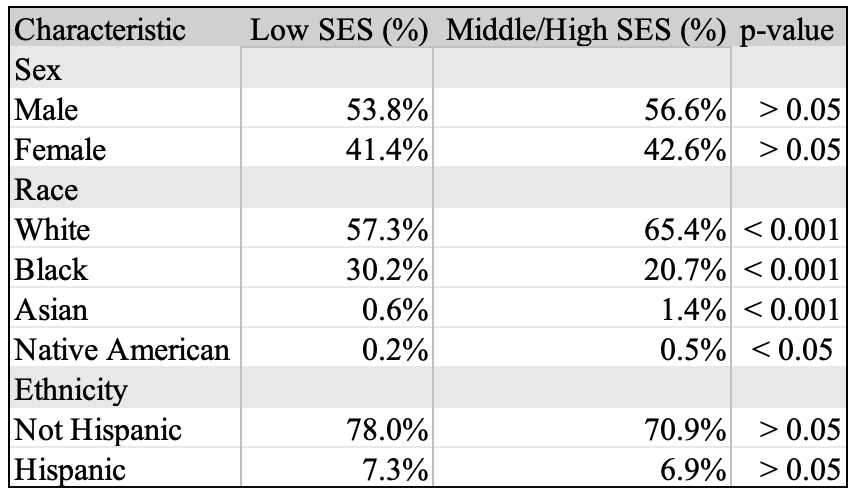Sunday Poster Session
Category: Liver
P1519 - Socioeconomic Disparities in Hepatitis C: Higher Treatment Success Among Low SES Patients Despite Barriers to Access
Sunday, October 26, 2025
3:30 PM - 7:00 PM PDT
Location: Exhibit Hall

Morgan R. Starkey, MD (she/her/hers)
MetroHealth Medical Center
Aurora, OH
Presenting Author(s)
Morgan R. Starkey, MD1, Adrian S. Lindsey, MD2
1MetroHealth Medical Center, Cleveland, OH; 2Metrohealth/CWRU, Cleveland, OH
Introduction: Chronic hepatitis C affects around an estimated 2.2 million adults in the US, with 93,805 new cases reported in 2022. States with higher poverty levels report the highest cases per capita, with Oklahoma having the highest rate at 150 cases per 100,000 people and a poverty rate of 15.27%, the ninth highest in the US. Since the development of curative treatment in 2013, studies have demonstrated that socioeconomic status (SES) influences access to hepatitis C treatment, resulting in lower resolution rates among the impoverished. However, this study aims to investigate if low SES negatively impacts the sustained viremic response of hepatitis C after initiating treatment once barriers to access are resolved.
Methods: TriNetX was used to identify patients with chronic hepatitis C in the United States who received antiviral HCV medications during their disease course. Patients were categorized into low or middle/high SES groups based on documented problems related to housing, economic circumstances, and employment. Demographics, including sex, race, and ethnicity, were also analyzed. Sustained virologic response (SVR) was calculated for each group as the primary outcome.
Results: A cohort of 103,535 patients across 68 healthcare organizations were identified as living with chronic hepatitis C taking antiviral medications, with 8,283 (8.0%) categorized as low SES. Among all patients treated with antiviral medications, only 45,088 (43.5%) achieved documented SVR. Despite having less access to antiviral therapy, low SES patients achieved a significantly higher SVR rate (49.1%) compared to middle/high SES patients (43.1%, p < 0.001). Among races, this was only reflected in African Americans (p < 0.001), while Whites, Asians, and Native Americans of middle/high SES had higher rates of SVR (p < 0.001). There was no statistically significant difference between sex and ethnicity (p > 0.05).
Discussion: While it is established that individuals of lower SES are disproportionately affected by hepatitis C and face barriers to accessing antiviral medications, this study highlights a lesser-explored area: whether SES impacts the likelihood of treatment success once access is achieved. Interestingly, those of low SES demonstrated a higher likelihood of achieving SVR compared to middle/high SES patients, particularly among African Americans. This finding warrants further exploration to identify potential reasons and supports prioritizing funding for public health programs aimed at hepatitis C eradication.

Figure: Table 1. Summary table with comparison of key metrics and their statistical significance

Figure: Table 2. SVR rates in low and middle/high SES by demographics and statistical significance
Disclosures:
Morgan Starkey indicated no relevant financial relationships.
Adrian Lindsey indicated no relevant financial relationships.
Morgan R. Starkey, MD1, Adrian S. Lindsey, MD2. P1519 - Socioeconomic Disparities in Hepatitis C: Higher Treatment Success Among Low SES Patients Despite Barriers to Access, ACG 2025 Annual Scientific Meeting Abstracts. Phoenix, AZ: American College of Gastroenterology.
1MetroHealth Medical Center, Cleveland, OH; 2Metrohealth/CWRU, Cleveland, OH
Introduction: Chronic hepatitis C affects around an estimated 2.2 million adults in the US, with 93,805 new cases reported in 2022. States with higher poverty levels report the highest cases per capita, with Oklahoma having the highest rate at 150 cases per 100,000 people and a poverty rate of 15.27%, the ninth highest in the US. Since the development of curative treatment in 2013, studies have demonstrated that socioeconomic status (SES) influences access to hepatitis C treatment, resulting in lower resolution rates among the impoverished. However, this study aims to investigate if low SES negatively impacts the sustained viremic response of hepatitis C after initiating treatment once barriers to access are resolved.
Methods: TriNetX was used to identify patients with chronic hepatitis C in the United States who received antiviral HCV medications during their disease course. Patients were categorized into low or middle/high SES groups based on documented problems related to housing, economic circumstances, and employment. Demographics, including sex, race, and ethnicity, were also analyzed. Sustained virologic response (SVR) was calculated for each group as the primary outcome.
Results: A cohort of 103,535 patients across 68 healthcare organizations were identified as living with chronic hepatitis C taking antiviral medications, with 8,283 (8.0%) categorized as low SES. Among all patients treated with antiviral medications, only 45,088 (43.5%) achieved documented SVR. Despite having less access to antiviral therapy, low SES patients achieved a significantly higher SVR rate (49.1%) compared to middle/high SES patients (43.1%, p < 0.001). Among races, this was only reflected in African Americans (p < 0.001), while Whites, Asians, and Native Americans of middle/high SES had higher rates of SVR (p < 0.001). There was no statistically significant difference between sex and ethnicity (p > 0.05).
Discussion: While it is established that individuals of lower SES are disproportionately affected by hepatitis C and face barriers to accessing antiviral medications, this study highlights a lesser-explored area: whether SES impacts the likelihood of treatment success once access is achieved. Interestingly, those of low SES demonstrated a higher likelihood of achieving SVR compared to middle/high SES patients, particularly among African Americans. This finding warrants further exploration to identify potential reasons and supports prioritizing funding for public health programs aimed at hepatitis C eradication.

Figure: Table 1. Summary table with comparison of key metrics and their statistical significance

Figure: Table 2. SVR rates in low and middle/high SES by demographics and statistical significance
Disclosures:
Morgan Starkey indicated no relevant financial relationships.
Adrian Lindsey indicated no relevant financial relationships.
Morgan R. Starkey, MD1, Adrian S. Lindsey, MD2. P1519 - Socioeconomic Disparities in Hepatitis C: Higher Treatment Success Among Low SES Patients Despite Barriers to Access, ACG 2025 Annual Scientific Meeting Abstracts. Phoenix, AZ: American College of Gastroenterology.
